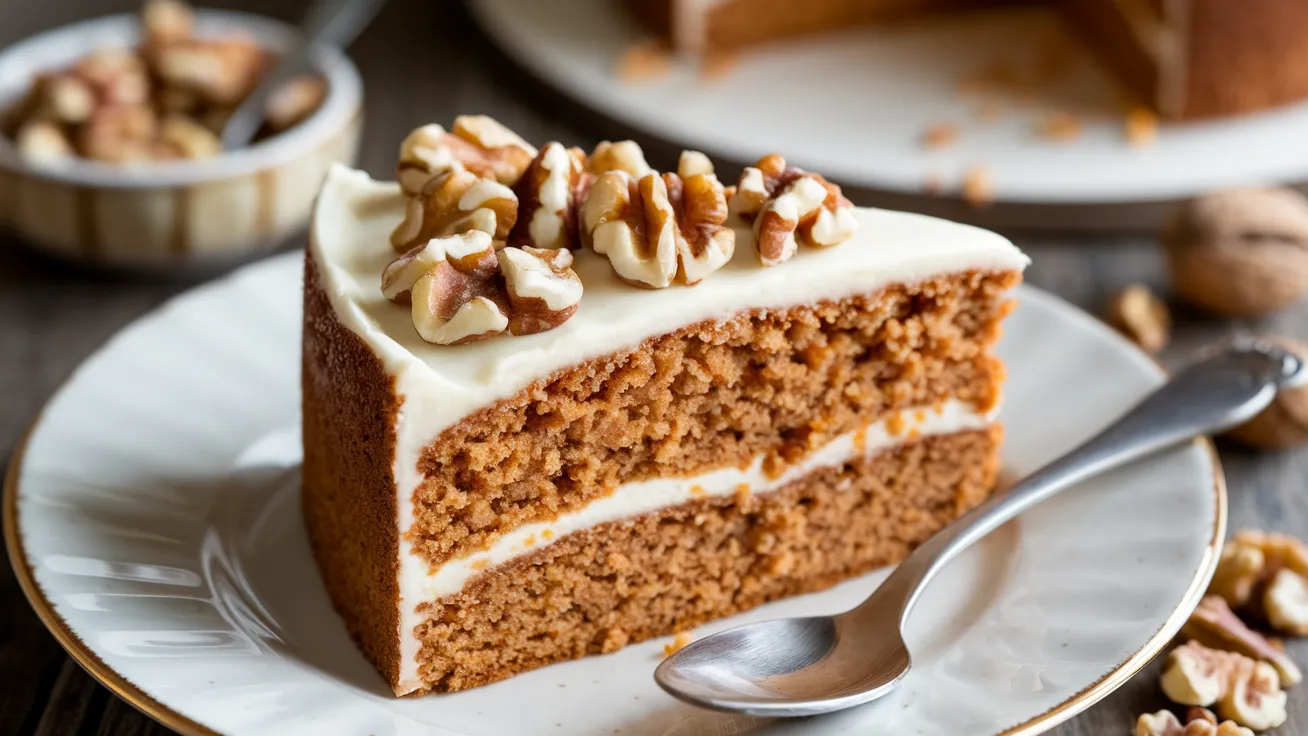Gluten free carrot cake is the perfect dessert for anyone craving a sweet, spiced classic without the gluten. Whether you have a gluten intolerance or simply want a healthier alternative to traditional baking, this guide will walk you through everything you need to know to make a moist, flavorful, and completely satisfying carrot cake—no gluten needed.
Whether you’re a seasoned gluten-free baker or just starting out, you’ll learn everything from choosing the right flours to keeping your cake moist without crumbling apart. We’ll also cover dairy-free frosting options, healthy ingredient swaps, and how to store your cake for later.
Table of Contents
Table of Contents
Understanding Gluten Free Carrot Cake
What is Gluten Free Carrot Cake?
Gluten free carrot cake is a modern twist on the beloved classic. Traditionally made with all-purpose wheat flour, this version swaps it out for gluten-free flours like almond flour, rice flour, or certified gluten-free oats. The rest of the cake remains just as delicious—grated carrots, spices like cinnamon and nutmeg, nuts or raisins, and usually topped with a rich cream cheese frosting.
Gluten free doesn’t mean taste-free. In fact, the natural sweetness of carrots combined with the right blend of flours can result in an even better texture and flavor than the traditional version. With the right ingredients, you can enjoy a moist, fluffy cake that no one will guess is gluten free.
Why Go Gluten-Free with Classic Desserts?
There are several reasons people switch to gluten-free diets—celiac disease, gluten intolerance, or just a preference for less processed ingredients. But many fear they’ll have to give up their favorite baked goods. Thankfully, that’s no longer true.
Going gluten-free in baking, especially in desserts like carrot cake, opens up opportunities to explore more nutritious alternatives. Flours like almond and coconut flour add protein and healthy fats. You also avoid the bloated feeling some experience with traditional wheat-based cakes.
Additionally, gluten free baking often encourages the use of whole ingredients and natural sweeteners, making your desserts feel more wholesome and less like a sugar bomb.
Ingredients Breakdown for a Perfect Gluten Free Carrot Cake
Essential Ingredients for Gluten-Free Baking Success
Creating a truly irresistible gluten free carrot cake starts with the right ingredients. Unlike traditional baking, where all-purpose flour does most of the work, gluten-free recipes depend on a carefully balanced mix of ingredients to achieve the same softness, structure, and taste.
Here’s a breakdown of must-have ingredients for your next gluten free carrot cake:
- Grated carrots – Freshly grated carrots are a must. They not only add moisture but also lend natural sweetness.
- Gluten-free flour blend – Pre-mixed blends often include a combination of rice flour, potato starch, and tapioca flour. These mimic wheat flour’s binding properties and create a fluffy texture.
- Eggs – Crucial for binding the cake and providing structure, especially important in gluten-free baking.
- Oil – A neutral oil like vegetable or avocado oil keeps the cake moist. Coconut oil is another great choice for a slight tropical touch.
- Brown sugar or coconut sugar – These add depth of flavor and help retain moisture.
- Spices – Cinnamon, nutmeg, and ginger add that signature warmth every carrot cake needs.
- Baking soda and baking powder – Leavening agents are key for a light, risen crumb.
- Chopped nuts or raisins (optional) – Walnuts and pecans add texture, while raisins introduce a natural pop of sweetness.
For a richer flavor and better texture, always choose fresh, whole ingredients when preparing your gluten free carrot cake batter.
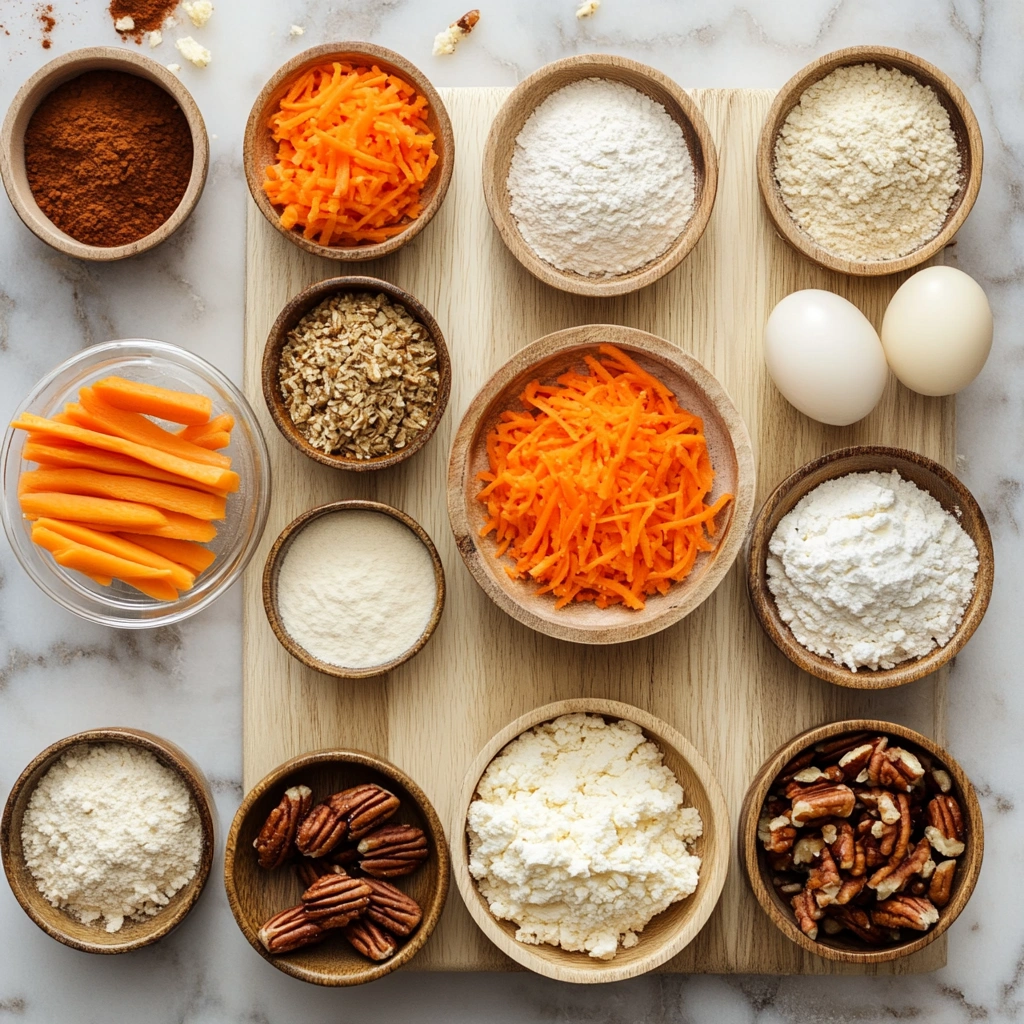
Substitutions and Additions for Flavor and Texture
One of the joys of baking a gluten free carrot cake is how customizable it is. Whether you’re accommodating dietary needs or just experimenting with flavor, these swaps and additions will elevate your cake:
- Dairy-Free Alternatives: Use almond milk or oat milk instead of regular milk. Vegan butter or coconut oil works great in place of dairy butter.
- Sweetener Swaps: Try maple syrup, honey, or agave if you’re cutting back on refined sugar. Just reduce other liquids slightly to keep the texture balanced.
- Fruit Purees: Add crushed pineapple or unsweetened applesauce for extra moisture and a touch of natural sweetness.
- Zest and Vanilla: Orange zest or a splash of real vanilla extract enhances the complexity of your cake’s flavor.
- Texture Additions: Shredded coconut, chopped dried fruits, or sunflower seeds can provide an interesting texture and nutrient boost.
These thoughtful changes don’t just accommodate special diets—they make your gluten free carrot cake uniquely delicious.
Looking for inspiration? Try our naturally sweet, allergen-friendly AIP banana bread recipe for another easy, gluten-free treat.
Choosing the Right Gluten-Free Flour
Best Flours for Gluten Free Carrot Cake
One of the biggest secrets behind a soft, tender gluten free carrot cake lies in the choice of flour. Since gluten is what gives traditional baked goods their structure and chew, replacing it effectively takes a little know-how—and the right combination of gluten-free flours.
Here are the most popular and effective flour choices:
| Gluten-Free Flour | Texture & Flavor | Best Use |
|---|---|---|
| Almond Flour | Moist, nutty flavor | Adds richness and softness |
| Coconut Flour | Absorbent, sweet flavor | Use sparingly—too much can dry the cake |
| Oat Flour (GF Certified) | Mild, whole grain taste | Great for light, fluffy texture |
| Rice Flour | Neutral taste, smooth finish | Blends well with starches for structure |
| Sorghum Flour | Earthy, slightly sweet | Works well in mixes for balanced flavor |
| Tapioca or Arrowroot | Adds chewiness and elasticity | Helps mimic the texture of gluten |
The best gluten free carrot cake recipes usually use a blend of two or more flours to mimic the structure and softness of wheat flour. For example, combining almond flour with oat flour and a bit of tapioca starch can create a well-balanced, fluffy cake.
If you’re new to gluten-free baking, starting with a trusted gluten-free flour blend (available in most grocery stores) is a smart move. Just make sure it includes xanthan gum or guar gum—key ingredients for binding and elasticity.
Homemade vs Store-Bought Gluten-Free Flour Blends
When it comes to baking a flawless gluten free carrot cake, you can either opt for a pre-made flour blend or make your own from scratch. Each choice has its perks.
Store-Bought Blends: Convenience and Consistency
These are perfect for beginners or anyone short on time. Brands like Bob’s Red Mill or King Arthur offer consistent results and already include binding agents like xanthan gum.
Pros:
- Easy to use
- Balanced flavor
- Consistent results
Cons:
- Can be more expensive
- Not all blends are created equal (read the labels!)
Homemade Blends: Control and Customization
Want to take full control of your ingredients? Homemade flour blends let you customize based on taste, texture, and dietary needs.
Sample Homemade Blend Recipe:
- 1 cup almond flour
- 1 cup gluten-free oat flour
- ½ cup tapioca starch
- 1 tsp xanthan gum
This blend works beautifully in gluten free carrot cake, especially when you want a moist crumb with just the right amount of fluff.
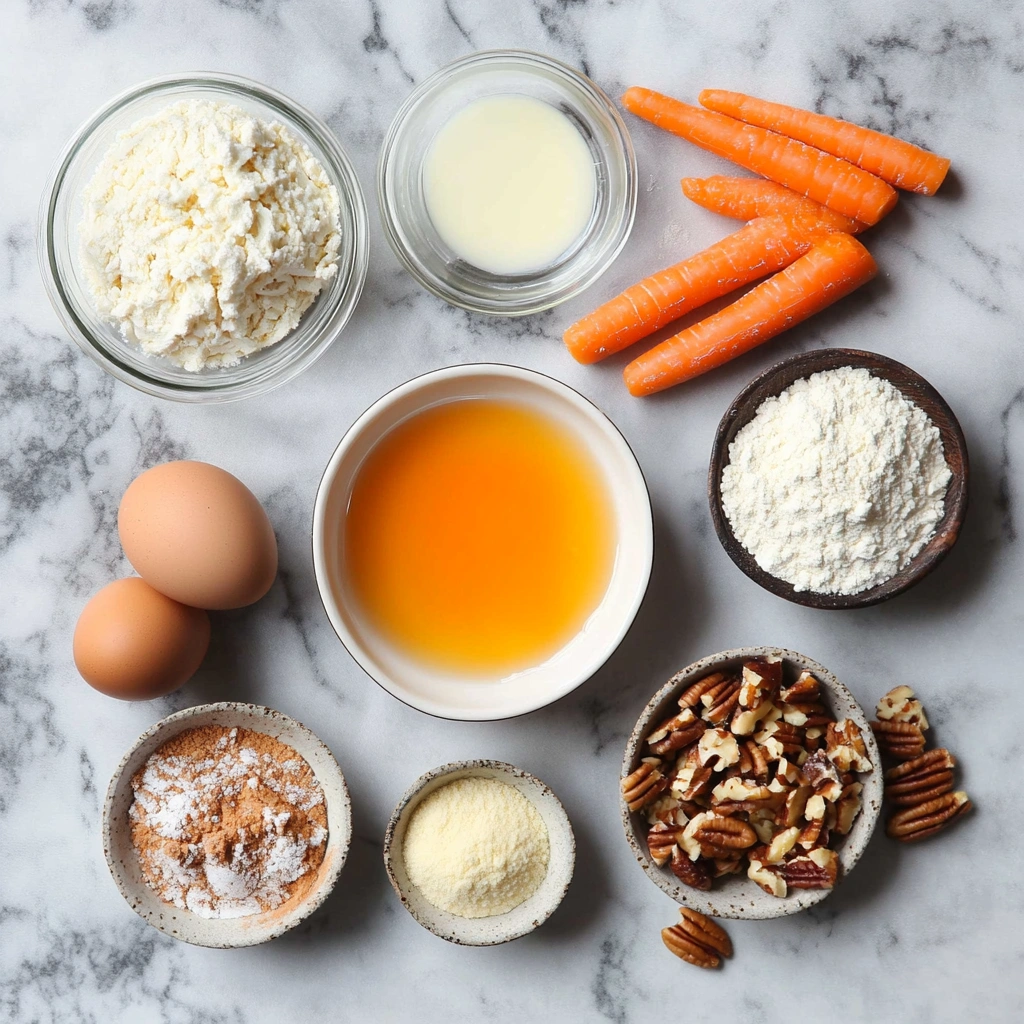
How to Make Gluten Free Carrot Cake Moist and Fluffy
Key Tips to Retain Moisture
One of the biggest challenges when baking a gluten free carrot cake is preventing it from drying out. Gluten helps retain moisture in traditional baking, so when it’s removed, you’ll need to be strategic with your ingredients and methods.
Here’s how to ensure your gluten free carrot cake comes out soft, moist, and just the right amount of dense every time:
- Use oil instead of butter: Oil traps moisture better than butter. Canola, avocado, or coconut oil all work great.
- Add moisture-rich ingredients: Crushed pineapple, applesauce, or Greek yogurt (or dairy-free yogurt) can significantly boost hydration.
- Don’t overbake: Gluten-free cakes dry out faster. Bake until a toothpick inserted comes out mostly clean—don’t wait for it to be completely dry.
- Keep your batter wet: Gluten free flours tend to absorb more liquid, so a slightly wetter batter leads to better moisture post-bake.
- Cover while cooling: Once out of the oven, lightly cover your cake with a clean towel while it cools. This traps steam and adds to the moistness.
Even if you’re following the best gluten free carrot cake recipe, missing just one of these details can result in a dry or crumbly cake. These little tricks make all the difference.
Techniques to Avoid a Crumbly Cake
Ever had a gluten free carrot cake fall apart as you cut into it? You’re not alone. Crumbliness is a common issue because gluten provides the structure that holds traditional cakes together. But don’t worry—you can prevent this with a few smart baking moves.
Use a Binding Agent
Xanthan gum or guar gum is essential in gluten-free baking. They mimic the elasticity of gluten, helping your ingredients stick together. If your flour blend doesn’t include one, add ½ teaspoon per cup of flour.
Don’t Skip the Eggs
Eggs are crucial for structure and moisture. For egg-free versions, use flax eggs or a commercial egg replacer with binding properties.
Let the Batter Rest
Give your batter 20–30 minutes to rest before baking. This allows the gluten-free flours to absorb liquids fully, creating a sturdier crumb.
Avoid Over-Mixing
While resting is important, over-mixing can actually break down structure. Mix until just combined to keep your gluten free carrot cake fluffy and firm.
Use the Right Pan
A good non-stick or parchment-lined cake pan helps your cake release cleanly without breaking. Also, cooling in the pan for 10–15 minutes before transferring reduces breakage.
By using these tried-and-true techniques, your gluten free carrot cake will hold its shape, slice beautifully, and impress everyone at the table.
Step-by-Step Gluten Free Carrot Cake Recipe
Step-by-Step Instructions with Pro Tips
Ready to bake the ultimate gluten free carrot cake? This easy, foolproof recipe guarantees a cake that’s moist, flavorful, and surprisingly simple to make—even if you’re new to gluten-free baking. Follow these steps carefully to get bakery-style results right at home.
Ingredients You’ll Need
Dry Ingredients:
- 2 cups gluten-free flour blend (with xanthan gum)
- 1 ½ teaspoons baking soda
- 1 teaspoon baking powder
- 1 ½ teaspoons ground cinnamon
- ½ teaspoon ground nutmeg
- ½ teaspoon ground ginger
- ½ teaspoon salt
Wet Ingredients:
- 1 cup brown sugar
- ½ cup granulated sugar
- ¾ cup vegetable oil (or melted coconut oil)
- 4 large eggs
- 2 teaspoons vanilla extract
- 2 cups finely grated carrots (fresh)
- ½ cup crushed pineapple (drained)
- ½ cup chopped walnuts or pecans (optional)
- ½ cup unsweetened applesauce
Pro Tip: Always use room temperature eggs and ingredients. This ensures better mixing and even baking, helping your gluten free carrot cake turn out moist and fluffy.
Step-by-Step Instructions
- Preheat and Prep
Preheat your oven to 350°F (175°C). Grease two 8-inch round cake pans and line with parchment paper. - Mix Dry Ingredients
In a large bowl, whisk together the gluten-free flour, baking soda, baking powder, spices, and salt. - Whisk Wet Ingredients
In a separate bowl, beat the brown sugar, granulated sugar, and oil until combined. Add the eggs one at a time, then stir in vanilla. - Combine and Fold
Slowly add the dry ingredients to the wet mixture, stirring gently. Once fully incorporated, fold in grated carrots, pineapple, applesauce, and nuts (if using). - Rest the Batter
Let your batter sit for about 15 minutes. This allows the flour to absorb liquid, making your gluten free carrot cake less crumbly and more cohesive. - Bake
Divide the batter between the pans. Bake for 30–35 minutes or until a toothpick comes out clean from the center. - Cool Completely
Let cakes cool in pans for 10–15 minutes, then transfer to wire racks to cool completely before frosting.
This recipe makes two layers of moist, flavorful gluten free carrot cake that hold together beautifully and taste even better the next day.
Mistakes to Avoid When Baking Gluten-Free
Even with a solid recipe, small missteps can sabotage your gluten free carrot cake. Here are a few things to avoid:
- Skipping the rest time: Don’t rush the batter into the oven—let it sit so flours hydrate properly.
- Overbaking: Gluten-free cakes dry out quickly. Always check at the 30-minute mark.
- Too much flour: Gluten-free flours are denser. Weighing your flour with a digital scale ensures accuracy.
- Overmixing the batter: This can create a gummy texture. Mix only until just combined.
Avoiding these mistakes will save your cake—and your sanity.
Frosting Ideas for Gluten Free Carrot Cake
Classic Cream Cheese Frosting (Gluten-Free)
No gluten free carrot cake is truly complete without a rich, velvety layer of cream cheese frosting. This classic pairing adds a tangy contrast that enhances the sweet, spiced notes of the cake. The good news? Traditional cream cheese frosting is naturally gluten-free, as long as you verify each ingredient label for hidden gluten.
Ingredients:
- 8 oz cream cheese, softened
- ½ cup unsalted butter, softened
- 2 cups powdered sugar (gluten-free certified)
- 1 tsp vanilla extract
- Pinch of salt
Instructions:
- Beat the softened cream cheese and butter until smooth and creamy.
- Gradually add powdered sugar, ½ cup at a time, mixing until fully incorporated.
- Stir in vanilla extract and a pinch of salt.
- Beat until light and fluffy—about 2 to 3 minutes.
This frosting spreads easily on a cooled gluten free carrot cake and holds its shape well if you’re decorating. For best results, chill the cake slightly before frosting.
Dairy-Free and Vegan Frosting Options
If you’re avoiding dairy or eggs, you can still top your gluten free carrot cake with a frosting that’s just as creamy and delicious. These dairy-free options are plant-based and easy to whip up.
Vegan “Cream Cheese” Frosting
Ingredients:
- 1 cup dairy-free cream cheese (cashew-based or almond)
- ¼ cup vegan butter
- 2 cups powdered sugar
- 1 tsp lemon juice or apple cider vinegar
- 1 tsp vanilla extract
Instructions:
- Cream the vegan butter and dairy-free cream cheese until smooth.
- Add lemon juice and vanilla.
- Beat in powdered sugar slowly until desired texture is reached.
This version gives your gluten free carrot cake that same tangy-sweet richness with a fully vegan twist.
Coconut Whipped Frosting
For a lighter, tropical note:
Ingredients:
- 1 can full-fat coconut milk (chilled overnight)
- 2 tbsp maple syrup
- ½ tsp vanilla
Scoop out the solid cream, whip it with maple syrup and vanilla, and top your cooled cake for a fresh, fluffy finish.
You’ll love the contrast of flavors between the warm spices of the cake and the cool, creamy frosting. Pair it with toasted coconut flakes or chopped nuts for extra flair.
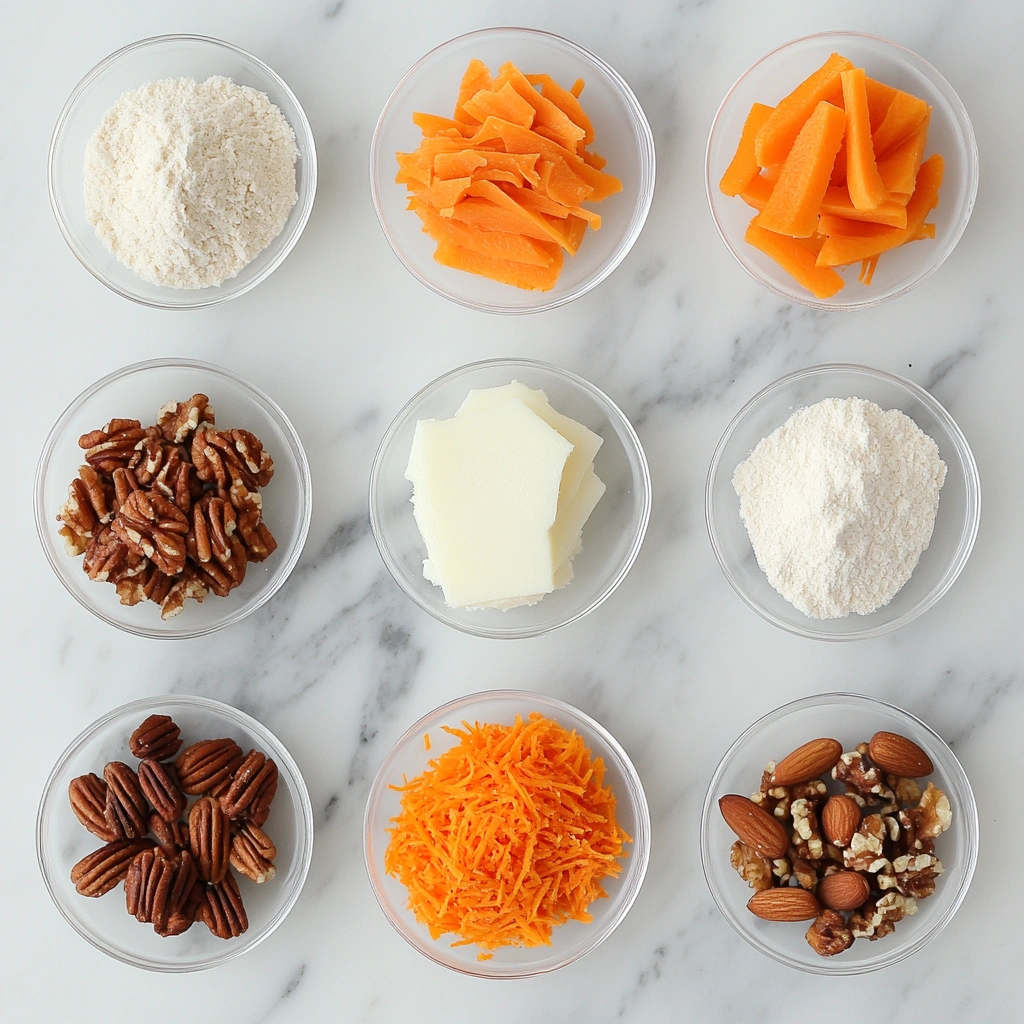
Don’t miss our fresh and fruity lemon custard with strawberry compote—a perfect gluten-free dessert pairing for carrot cake fans.
Variations and Twists on the Classic Gluten Free Carrot Cake
Nut-Free, Vegan, and Paleo Options
One of the best things about gluten free carrot cake is its versatility. Whether you’re avoiding nuts, going vegan, or following a paleo lifestyle, this cake adapts beautifully. Below are some of the most delicious and dietary-friendly variations you can try at home.
Nut-Free Carrot Cake
Many people love the crunch of walnuts or pecans in their carrot cake, but for those with nut allergies, this variation is completely safe and still rich in flavor.
Nut-Free Substitutes:
- Use sunflower seeds or pumpkin seeds for texture.
- Add shredded coconut for richness.
- Increase the amount of grated carrot or pineapple to add moisture and complexity.
With these swaps, your gluten free carrot cake will still be moist, fluffy, and full of texture—without any risk of nut allergies.
Vegan Gluten Free Carrot Cake
To make a 100% plant-based version:
- Replace eggs with flax eggs (1 tbsp ground flax + 3 tbsp water per egg).
- Use coconut oil or vegan butter.
- Choose a dairy-free milk (almond, soy, oat).
- Opt for a vegan cream cheese frosting or coconut whipped frosting.
This version keeps everything you love about gluten free carrot cake—minus the animal products.
Paleo-Friendly Twist
Want a grain-free option?
- Use almond flour or a mix of almond and coconut flour.
- Sweeten with maple syrup or raw honey.
- Skip refined sugar and use mashed banana or applesauce for moisture.
- Add chopped dates or raisins for a natural sweetness burst.
Paleo versions tend to be more nutrient-dense and lower in sugar, without sacrificing flavor or texture.
Carrot Cake Cupcakes and Sheet Pan Versions
If you’re not in the mood for a full cake—or you’re baking for a crowd—there are plenty of creative ways to serve gluten free carrot cake.
Cupcake Version
Perfect for parties, school lunches, or meal prepping. Simply pour your cake batter into a lined muffin tin and reduce the baking time to 20–22 minutes. Top with a dollop of cream cheese frosting and a sprinkle of cinnamon.
Sheet Pan Carrot Cake
Need a quick and easy option? Pour the batter into a greased 9×13” pan and bake for about 30–35 minutes. This version is ideal for potlucks, bake sales, or birthday parties. Plus, it’s easier to frost and slice.
Other serving ideas:
- Make a trifle with carrot cake cubes, dairy-free whipped cream, and fruit.
- Turn it into carrot cake bars with a thick layer of frosting on top.
- Create layered cake jars for a cute, portable dessert.
Each variation still delivers the signature spiced flavor and rich texture that defines a truly great gluten free carrot cake, no matter how you slice it.
Discover great ideas like these Valentine’s Day cake pops if you’re exploring more creative, seasonal gluten-free desserts.
Storage, Shelf Life, and Freezing Tips
How to Store and Freeze Gluten Free Carrot Cake Properly
One of the great things about gluten free carrot cake is that it actually tastes better the next day. The flavors meld, the moisture deepens, and the texture becomes even more tender. But storing it the right way is key to maintaining freshness and flavor.
Room Temperature Storage (Short-Term)
If you haven’t frosted the cake yet, you can keep it tightly wrapped in plastic wrap or stored in an airtight container at room temperature for up to 2 days.
- Keep it away from heat or sunlight.
- Place a piece of parchment or wax paper between layers to prevent sticking.
Once frosted—especially with cream cheese or dairy-based frostings—gluten free carrot cake should be refrigerated.
Refrigerator Storage (Medium-Term)
Frosted cake will stay fresh in the fridge for up to 5 days. Store it in an airtight container or wrap it tightly with foil or plastic wrap.
- Let it sit at room temperature for 15–20 minutes before serving to regain its soft texture.
- For stacked or layered cakes, insert a few toothpicks on top and cover loosely to prevent smudging the frosting.
Freezing Instructions (Long-Term)
Yes, you can freeze gluten free carrot cake—and it freezes beautifully! Whether whole or sliced, here’s how:
For Unfrosted Cake:
- Wrap the cooled cake (whole or by layer) tightly in plastic wrap.
- Add a layer of aluminum foil or place in a freezer-safe container.
- Freeze for up to 3 months.
For Frosted Cake:
- Chill the cake in the refrigerator for 1–2 hours to firm up the frosting.
- Wrap carefully with plastic wrap and foil.
- Freeze slices individually for easy thaw-and-serve portions.
When ready to eat, move it to the fridge overnight, then let it come to room temperature before serving. This helps your gluten free carrot cake maintain its original moisture and structure.
Reheating and Serving Suggestions
Reheating isn’t always necessary, but if you prefer a warm slice:
- Microwave individual slices for 10–15 seconds (unfrosted) or 5–10 seconds (frosted).
- For larger portions, preheat the oven to 300°F (150°C), cover the cake with foil, and heat for 10–15 minutes until just warm.
Pair your warm gluten free carrot cake with a scoop of dairy-free vanilla ice cream or a drizzle of maple glaze for an extra treat.
These storage and serving tips help your cake stay delicious for days—if it lasts that long!
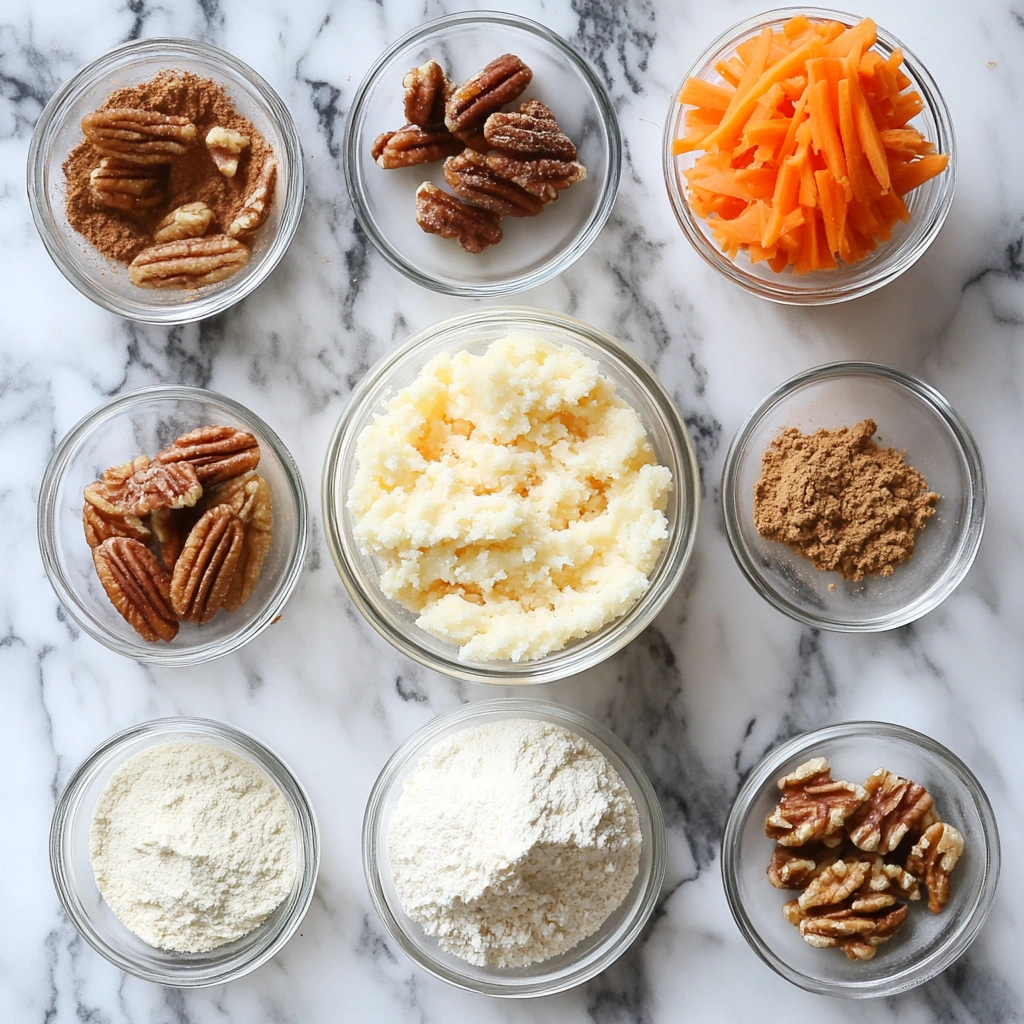
Frequently Asked Questions About Gluten Free Carrot Cake
What is gluten free carrot cake made of?
A traditional gluten free carrot cake uses a combination of gluten-free flours—like almond flour, rice flour, or a pre-made blend—as a substitute for wheat flour. Common ingredients also include grated carrots, eggs, oil, sweeteners (like brown sugar or maple syrup), baking soda, and warming spices such as cinnamon and nutmeg. Many recipes also include pineapple or applesauce to keep the cake moist.
Is gluten free carrot cake healthy?
Compared to standard carrot cake, gluten free carrot cake can be a healthier option—especially if you use unrefined sweeteners, heart-healthy oils, and add-ins like nuts or raisins for fiber and healthy fats. It’s also a good choice for those with gluten intolerance or celiac disease. However, like any dessert, moderation is key. For a lighter version, reduce the sugar and opt for a dairy-free or low-fat frosting.
Can I freeze gluten free carrot cake?
Absolutely. In fact, gluten free carrot cake freezes very well. Whether it’s frosted or unfrosted, you can wrap it tightly in plastic wrap, followed by foil, and freeze it for up to three months. Individual slices are great for quick desserts—just thaw in the fridge overnight or at room temperature for a few hours. When frozen properly, the flavor and texture stay wonderfully intact.
Why does gluten free carrot cake fall apart?
Crumbly texture is a common issue with gluten-free baking. Without gluten to provide structure, your cake can fall apart if the batter is too dry or lacks enough binding agents. To prevent this, always use a blend that includes xanthan gum or add it separately (½ tsp per cup of flour). Letting the batter rest before baking and not overbaking are also crucial steps to help your gluten free carrot cake hold together.
What flour is best for gluten free carrot cake?
The ideal flour for gluten free carrot cake depends on the texture and flavor you’re aiming for. A combination of almond flour, gluten-free oat flour, and tapioca starch works exceptionally well. If you prefer a simpler solution, a high-quality all-purpose gluten-free blend (with xanthan gum included) makes baking easier without compromising results.
Every flour behaves differently, so make sure to weigh your ingredients for accuracy and experiment with small batches to find what you love most.
How do I keep a gluten free cake moist?
Moisture is the key to success in any gluten free carrot cake recipe. Use ingredients like oil, applesauce, pineapple, or yogurt to boost hydration. Avoid overbaking and consider resting your batter before it goes into the oven. Cover the cake while cooling to trap steam, and store it properly (in airtight containers) to lock in moisture. Even leftover slices can stay soft for days with the right storage.
Bake the Perfect Gluten Free Carrot Cake Every Time
Whether you’re baking for dietary needs or just looking to make a healthier, more inclusive dessert, gluten free carrot cake proves that you don’t need gluten to create a show-stopping treat. With the right mix of gluten-free flours, moisture-rich ingredients, and a bit of baking know-how, you can whip up a cake that’s every bit as flavorful, moist, and indulgent as the original.
From understanding how to choose the perfect flour blend to mastering the art of moisture retention and customizing your frosting, this guide has covered everything you need to confidently bake a truly irresistible gluten free carrot cake. You’ve also discovered how to store, freeze, and serve it with flair, so your hard work lasts longer and tastes just as fresh the next day.
Whether you stick to the classic version or experiment with vegan, nut-free, or paleo twists, you’ll never look at gluten-free baking the same way again. So grab those carrots, preheat the oven, and treat yourself to a slice of homemade goodness—baked your way, and made to share.
For more information, visit this nice website.

